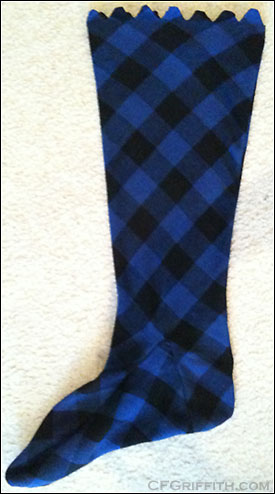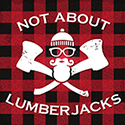
The cadadh I started -- we decided to stop working on it and just buy the type we need. The fabric most likely won't hold up, and it wasn't even the color we originally wanted.
I tried working on accessories for my husband last week. The good news is, I have a pattern to work with for different versions later, but we’ve decided to just buy these for now.
Cadadh
I tried to make cadadh, or bag hose, for my husband’s 18th century Highland costume. The problem is that he’s going for a fancier look, and I had my heart set on a castellated or similar top, instead of plain or fold-over cuff.
It’s difficult to be happy with something when you’re trying to make it fancier than you’d normally make.
The fabric
The biggest issue is the fabric. The colors are nice (I love blue), but we had hoped for red and black diced fabric.
The color wasn’t the only problem with the fabric. It was one of the first items we purchased when we decided to do 18th century costuming, so I can’t even remember what type of fabric it is. I only remember thinking it was probably one of the few times I would find diced fabric, so we bought it.
At the time, it had very little give even on the bias. I worried it would be uncomfortable for Christopher to wear. Once I washed it however, it was almost too flimsy.
When I cut it out following the pattern I’d made, it ended up HUGE in the calf. I’m still not sure how that happened since I was careful. I expected a possibility of a little difference, but not that much. It was an easy fix though, I just took it in even more. The fit was perfect. My husband loves how it feels, and said it was very comfortable.
Unfortunately, I noticed another issue with the fabric: holes and unraveling.
As I was hand sewing, I would catch glimpses of light from behind the fabric and realized the needle was leaving holes bigger than it should have been. I tried to fix the seams as best I could, but my husband goes through socks fast. I just knew the cadadh would not last very long.
The fancy top
Instead of doing the plain cuff, we decided to try out a fancier version. That’s when we really realized the fabric wasn’t worth it. I had to keep the seams in the little triangles small, but the fabric issues were worse there. I was already seeing ragged chunks of fabric fraying at the seams.
I would have needed to do a little more work to get the top edge to lay correctly when he was wearing the cadadh (I had to use another fabric cut on the bias to help give it a little more strength and keep it from stretching out more), but we decided to just stop at that point. I didn’t even finish turning the points out.
The pattern
It’s not a total loss, however. My husband will also have costumes with breeches, so he’ll need regular stockings. I feel very confident this pattern will work fine for those, or even regular cadadh if we find the right fabric.
Sometimes it’s better to just buy something for now
I also learned a lot, and got to test out some ideas. We just felt my time could be better spent elsewhere. Not to mention, since he wears a regular kilt, it’s nice to invest in accessories he can wear for both. We had asked a sporran maker who was familiar with 18th century, and he knew we weren’t going for re-enacting or 100% authenticity. He recommended a sporran type that will work for both 18th century costuming group needs, but not look out of place with modern kilt-wearing.



yep ! That was me visiting yesterday.
All the best, Cynthia.
Robert
Thanks for letting me know, Robert! Sorry if I scared you — I’d been checking my stats, and it was early enough here to be able to tell easily where the person visited on my site, how they found that page, and where they were from. Especially when you had posted your cadadh photos on XMTS and FB. Great job, by the way! 😀